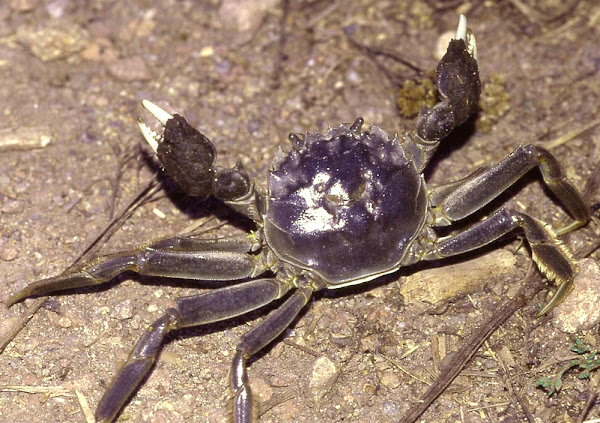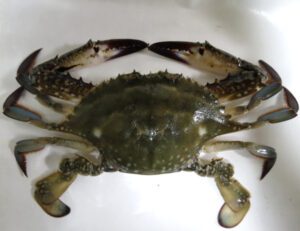The Chinese mitten crab is a medium-sized burrowing crab that is named for it’s furry claws, which resemble mittens.
It is also known as the Shanghai hairy crab, and it is native to rivers, estuaries and other coastal habitats of eastern Asia from Korea in the north to the Fujian province of China in the south.
It has also been introduced to Europe and North America. And it is considered an invasive species there.
The Chinese mitten crabs can be found in both freshwater and saltwater. They are walking crabs, and they can emerge from the water to move upstream of barriers and are capable of moving several hundred miles upstream from saltwater. However, read some more information about the Chinese mitten crab below.
Chinese Mitten Crab Characteristics
The Chinese mitten crab is a medium-sized crab, and it’s body is the size of a human palm. It’s most distinguishing features are the dense patches of dark setae on it’s claws.
The carapace is 3-10 cm wide, and the legs are about twice as long as the carapace is wide. These crabs have 8 sharp pointed walking legs (4 on each side), and they have no swimming legs.

They are brownish-orange to greenish-brown in color. Average live body weight of the mature Chinese mitten crab is around or up to 45 grams. Photo and info from Wikipedia.
Feeding
Chinese mitten crabs are omnivorous and opportunistic. Generally they consume a wide variety of plant and animal material.
Their food include algae, macrophytes, terrestrially derived detritus, invertebrates, fish carcasses and also steal a wide rage of bait from fishermen.
Breeding
The Chinese mitten crab spend most of it’s life in freshwater, and return to sea for breeding. In late August, the mature crabs begin migrating downstream to sea (away from their feeding grounds).
These crabs reach puberty and develop their reproductive organs during this migration. They begin to breed in the brakish water in late fall.
The male crabs arrive first and stay in the brackish water all winter, and the females arrive later. After successful mating, the females lay eggs within 24 hours.
Uses
The Chinese mitten crab is mainly used for food. It is an autumn delicacy in Shanghai cuisine and eastern China. It is prized for the female crab roe.
Special Notes
The Chinese mitten crab has been spread rapidly from Asia to North America and Europe (raising concerns that it competes with local species).
And burrowing nature of these crabs damages embankments and clogs drainage systems.
Management efforts have shown to be very difficult. This is due to its abundance, high reproductive rate, and high physiological tolerance. However, review full breed profile of the Chinese mitten crab in the chart below.
| Name | Chinese Mitten Crab |
| Kingdom | Animalia |
| Phylum | Arthropoda |
| Class | Malacostraca |
| Order | Decapoda |
| Family | Varunidae |
| Genus | Eriocheir |
| Species | E. sinensis |
| Binomial Name | Eriocheir sinensis |
| Other Names | Also known as the Shanghai hairy crab |
| Breed Purpose | Mainly food |
| Special Notes | Mainly used for food, an autumn delicacy in Shanghai cuisine and eastern China, prized for the female crab roe, it has been spread rapidly from Asia to North America and Europe, high reproductive rate |
| Breeding Method | Natural |
| Weight | Around 45 grams |
| Body Color | Brownish-orange to greenish-brown |
| Rarity | Common |
| Availability | Native area (worldwide) |






